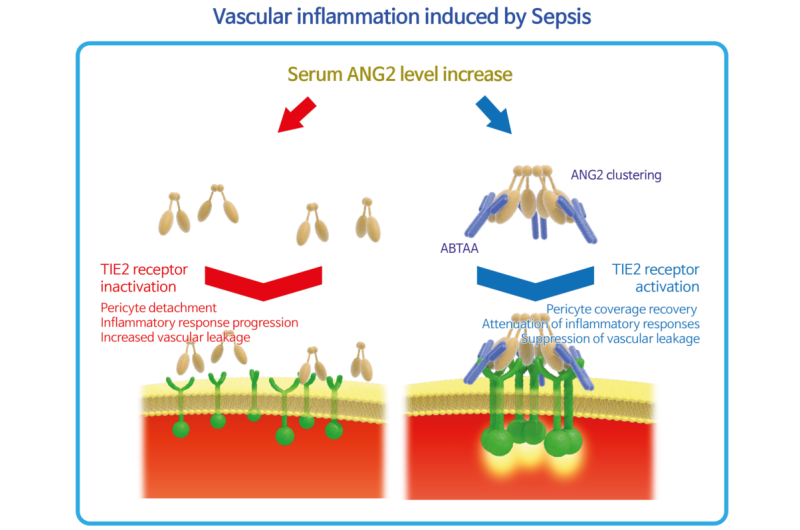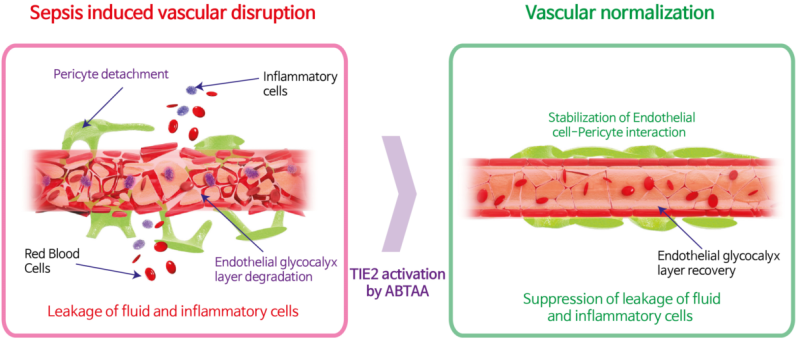Effects of sepsis negated by Tie2 activation-induced vascular protection

Sepsis, more commonly known as blood poisoning, is an exceptional healthcare problem. It is more common than heart attacks, and kills more people than any type of cancer and despite this, it remains largely unknown. According to a 2013 paper published in The New English Journal of Medicine1, it affects more than 19 million people around the world yearly and the number keeps increasing. There is hope for a reliable treatment, however, as researchers at the IBS Center for Vascular Health have developed a targeted therapy for mitigating sepsis by strengthening as well as protecting blood vessels.
Sepsis is caused by the immune system severely overreacting to an infection and attacking itself. The first thing that occurs is the weakening of blood vessels which makes them porous and causes vascular leakage leading to a cascade of compounding negative effects, including severe inflammation, organ damage, pulmonary edema and death. Since sepsis doesn't have a cure, instead of treating its symptoms head on doctors are only able to fight the underlying infection and hope that the body gets strong enough to combat the sepsis on its own.
The IBS team's new method for alleviating sepsis progression focuses on activating a receptor in the lining of blood vessels called endothelial cells. They induced a protein growth factor called Tie2, which stimulates blood vessel growth by using an anti-angiopoietin-2 (Ang2) antibody, called ABTAA (Ang2-binding and Tie2-activating antibody).
ABTAA works by simultaneously causing Ang2 inhibition and Tie2 activation. Under normal conditions, Ang2 is barely detectable in the body but during times of high stress (like a severe infection) it is created en masse and circulates through the bloodstream causing vascular cell death and making the blood vessels porous. ABTAA prevents this by causing Ang2 to clump together rendering it inert and unable to cause damage and also stimulating Tie2 which strengthens blood vessels. Also, encouragingly, the combination of ABTAA and antibiotics enhanced the survival rates of severe sepsis models up to 70%.

IBS researcher Seung Jun Lee uses his new process to "strengthen the blood vessels so the body has a stable environment to fight the infection which also prevents further damage". Using ABTAA will likely become a therapeutic treatment for sepsis and by eliminating the effects brought on by the immune system's severe overreaction; fatality from sepsis no longer appears to be inevitable.
Lee said, "In the past, treating sepsis meant fighting off the underlying infection but the immune system still attacked itself and people still died." ABTAA is a separate, independent treatment which eliminates the root cause of sepsis so the body has a strong battlefield to fight the infection. Use in sepsis treatment may be just the start for ABTAA. Heart attacks also cause major stress on the body which results in Ang2 production, and by reducing Ang2 production, ABTAA could alleviate the severity of the attacks and increase survivability. Even more intriguing is the possibility for ABTAA to be used as part of a cure for life-threatening infections such as the Ebola or MERS viruses since both are known to cause devastating disintegration of vascular systems.
More information: 1 D. C. Angus, T. van der Poll, Severe sepsis and septic shock. N Engl J Med 369, 840- 851 (2013).
Amelioration of sepsis by TIE2 activation–induced vascular protection," Science Translational Medicine, DOI: 10.1126/scitranslmed.aad9260


















